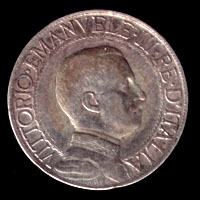
Son of Umberto I and Margherita of Savoia, Vittorio Emanuele III (Victor Emmanuel III) was born on 11 November 1869 in Naples and he ascended the throne in 1900. He celebrated the 25th anniversary of reign with the "Vetta d'Italia" series in 1925, that celebrates the 10th anniversary of World War I entry too. Fond of numismatics, from 1914 to 1943 he published the "Corpus Nummorum Italicorum", 20 volumes about the Italian coins since the end of the roman empire.
On 29 September 1911 he resumes the colonial initiative with the Italian invasion in Libya and of the islands of the Aegean Sea (May 1912); with the peace treaty of Losanna (18 October 1912) the Turkey recognizes the Italian acquisition of the Tripolitania and the Cirenaica. New tallers for the Eritrea was minted on 1918 and in 1909-1925 Italian coins for the Italian Somaliland was produced.
In the World War I (1915 - 1918) Italy was initially neutral; due to the irredentism of the Trentino and Venezia Giulia, Italy abandoned the Triple Alliance joined with the Germany and the Austria, and she fought on the side of the Allies, together with France and England. The victory arose to Italy and the key battle of the Piave (june 1918), that leaded to the final victory at Vittorio Veneto; the 10th Anniversary of the End of World War I was celebrated in 1928 with the "Helmet" series.
In the context of the economical and political crisis following the war, the country underwent a series of social agitations that the government was unable to control. On 23 March 1919 Benito Mussolini founded the "Fasci di Combattimento" in Milan, transformed into the National Fascist party in November 1921. After the march on Rome (26 October), Vittorio Emanuele III asked Mussolini to form a new cabinet on 28 October 1922. The 1st anniversary of the march on Rome and the Fascist Government was remembered in 1923 with the "Fasces" series and the 6th anniversary with the "Lictor" series. In April 1924 new elections was organized, but several irregularities occurred. The socialist deputy Giacomo Matteotti denounced these irregularities and was killed on 10 June 1924. On 3 January 1925 Mussolini claimed his responsibility for these events and the Fascist dictatorship begun. The starting year of the Fascist era was considered the 1922: the coins minted during the dictatorship reported both the "after Christ year" (in Arabic numeration), and the Fascist era format (in roman numeration).
In 1929 by the Lateran Treaty was ended the conflict between church and state following the Italian unification. On 3 October 1935 the Italian troops of Eritrea and Somalia invaded the Ethiopia; on 9 May 1936 the war finished with the proclamation of the Italian Empire of the East Africa: the "Empire" series celebrated this event. On April 1939 the Albania was occupied, with new coins minted for this country.
According to the Rome-Berlin Axis (October 1936) and the Steel Pact (22 May 1939), Italy enters in the World War II with the Germany on 10 June 1940. The English offensive in Africa in December 1940 caused the progressive loss of the Italian territories in Libya, concluded with the defeat of El Alamčin (3-4 November 1942). After the defeated of the Amba-Alagi (17 May), Italy lost the territories in Somalia, Eritrea and Ethiopia. Due to the failure of Italian arms in Greece and Africa and the imminent invasion by the Allies, on 25 July 1943 the Fascist Grand Council voted against continued support of Mussolini and Vittorio Emanuele III dismissed and arrest him. As premier was named Pietro Badoglio, who signed an armistice with the allied army on 3 September 1943, armistice published on 8 September. On 9 September the king fled to Brindisi to avoid to be captured by the Germans. On October 13th Italy declared war to the Germany. In the meantime, Mussolini was freed by the Germans on 1 September. In opposition to the Vittorio Emanuele III government (temporarily based at Brindisi), on 25 September 1943 Mussolini founded a new government, the Repubblica Sociale Italiana based at Sals. This situation provoked a civil war, ended on 25 April 1945 with the end of the War War II. The abdication of the king toke place on 9 May 1946 and on 2 June 1946 a referendum established the transition from the kingdom to the Italian republic.
Vittorio Emanuele III died in Alexandria of Egypt on 28 December 1947.
Copyright © ilMarengo.com
All rights reserved
Cookie policy